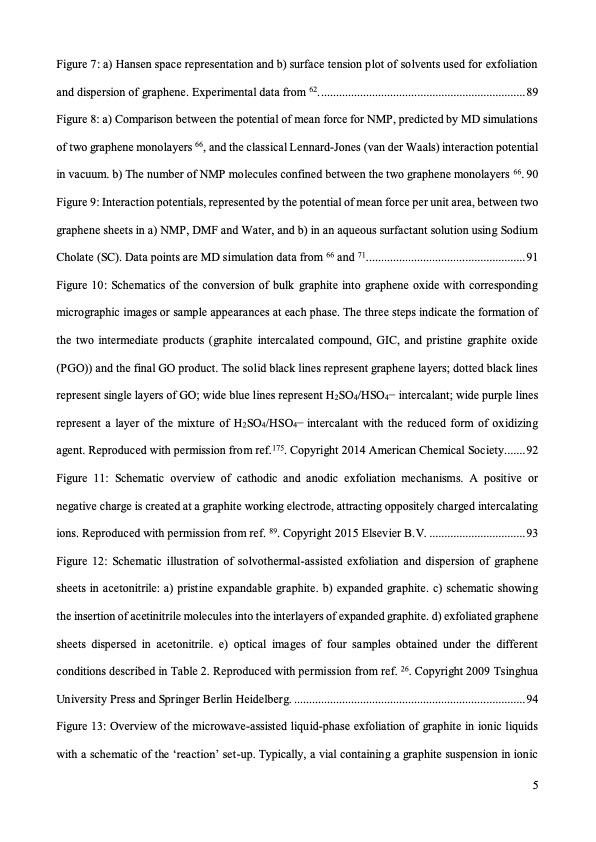PDF Publication Title:
Text from PDF Page: 005
Figure 7: a) Hansen space representation and b) surface tension plot of solvents used for exfoliation and dispersion of graphene. Experimental data from 62.....................................................................89 Figure 8: a) Comparison between the potential of mean force for NMP, predicted by MD simulations of two graphene monolayers 66, and the classical Lennard-Jones (van der Waals) interaction potential in vacuum. b) The number of NMP molecules confined between the two graphene monolayers 66. 90 Figure 9: Interaction potentials, represented by the potential of mean force per unit area, between two graphene sheets in a) NMP, DMF and Water, and b) in an aqueous surfactant solution using Sodium Cholate (SC). Data points are MD simulation data from 66 and 71.....................................................91 Figure 10: Schematics of the conversion of bulk graphite into graphene oxide with corresponding micrographic images or sample appearances at each phase. The three steps indicate the formation of the two intermediate products (graphite intercalated compound, GIC, and pristine graphite oxide (PGO)) and the final GO product. The solid black lines represent graphene layers; dotted black lines represent single layers of GO; wide blue lines represent H2SO4/HSO4− intercalant; wide purple lines represent a layer of the mixture of H2SO4/HSO4− intercalant with the reduced form of oxidizing agent. Reproduced with permission from ref.175. Copyright 2014 American Chemical Society.......92 Figure 11: Schematic overview of cathodic and anodic exfoliation mechanisms. A positive or negative charge is created at a graphite working electrode, attracting oppositely charged intercalating ions. Reproduced with permission from ref. 89. Copyright 2015 Elsevier B.V. ................................93 Figure 12: Schematic illustration of solvothermal-assisted exfoliation and dispersion of graphene sheets in acetonitrile: a) pristine expandable graphite. b) expanded graphite. c) schematic showing the insertion of acetinitrile molecules into the interlayers of expanded graphite. d) exfoliated graphene sheets dispersed in acetonitrile. e) optical images of four samples obtained under the different conditions described in Table 2. Reproduced with permission from ref. 26. Copyright 2009 Tsinghua University Press and Springer Berlin Heidelberg. .............................................................................94 Figure 13: Overview of the microwave-assisted liquid-phase exfoliation of graphite in ionic liquids with a schematic of the ‘reaction’ set-up. Typically, a vial containing a graphite suspension in ionic 5PDF Image | graphene production via nonoxidizing liquid exfoliation

PDF Search Title:
graphene production via nonoxidizing liquid exfoliationOriginal File Name Searched:
Graphene-R2-review.pdfDIY PDF Search: Google It | Yahoo | Bing
Salgenx Redox Flow Battery Technology: Power up your energy storage game with Salgenx Salt Water Battery. With its advanced technology, the flow battery provides reliable, scalable, and sustainable energy storage for utility-scale projects. Upgrade to a Salgenx flow battery today and take control of your energy future.
CONTACT TEL: 608-238-6001 Email: greg@infinityturbine.com (Standard Web Page)